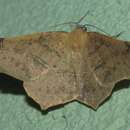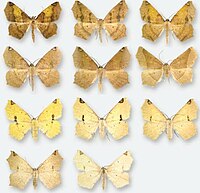pms
nòm ant ël fil


Antepione comstocki Sperry 1939 , syn. n.
Antepione costinotata Taylor 1905
Eugonobapta constans Hulst 1898 , syn. n.
Metanema vanusaria Strecker 1899 : 6, syn. rev.
Tetracis indiscretata Edwards 1884 : 48, syn. n.
Type material.
Female HT (Fig. 2), New Mexico, [San Miguel Co.], Las Vegas, July, 1882. [SEMC].
Antepione comstocki male HT (Fig. 5), Arizona, [Pima Co.], Baboquivari Mts., 26 April, 1938 [CNC]. Tetracis indiscretata female HT (Fig. 3), New Mexico, [San Miguel Co.], Las Vegas, August, 1882 [SEMC]. Eugonobapta constans male HT (Fig. 4), Arizona, [Yavapai Co.], Prescott, August, 1896 [AMNH].
Other material examined.
145 specimens in [CDF] from Arizona, Colorado and New Mexico; additional material (some by photographs) from Arizona (including a reared series), Colorado, New Mexico, Texas, Mexico.
Diagnosis.
Antepione imitata is most easily separated from Antepione thisoaria based on geography. It does not occur east of west Texas and is not recorded from Central America , while Antepione thisoaria extends west only to the 95th parallel. In the male genitalia, the apical region of the valva exhibits 3 long robust spines and additional fine setae, which are not present in the valva of thisoaria. In the female genitalia, the corpus bursae is not initially swollen as in Antepione thisoaria .
Description.
Adults. As described above for the genus. Genitalia. Figs 4, 31-33. Dissections 8m, 2f comprising full range of phenotypes). Male genitalia - Uncus stout, slightly decurved, tapering to a rounded tip; gnathos with unjoined slender arms, medial gnathos with a few small teeth; valva rounded at apex with 3 long robust spines and additional fine setae, produced ventral ridge forming two short projections; anellus with two sclerotized spinose lobes; aedeagus truncate with one large oblong cornutus near base of vesica. Female genitalia - Apophyses long, slender; posterior apophyses ca. 1.8 × anterior apophyses; ductus bursae ridged, short, partially sclerotized at posterior; corpus bursae without signum, long and cylindrical with membranous anterior sac; ductus seminalis originates at top of ductus bursae.
Remarks. One male specimen (Fig. 25) of the comstocki phenotype examined from Las Animas Co., Colorado lacks the characteristic DFW costal triangular patch, causing it to resemble superficially the ligata form of Pionenta ochreata . The male genitalia, however, are typical of Antepione imitata .
Biology and distribution
(Fig. 59). Noel McFarland (Hereford, AZ) reared the species on Ribes aureum Push. from ova from an adult female of the nearly uniformly brownish-ochreous April–May generation; adults emerged June–July . The resulting adults are of the form with yellow females and males in which the DFW medial band has a yellow flush. Based on my field studies over many years in southeastern Arizona and southwestern New Mexico and McFarland’s reared material, there appear to be three generations in southeastern Arizona and Southwestern New Mexico. There is a strong early flight starting in April and early May, with a weaker flight in late June into July, and another strong flight beginning in mid-August after the monsoonal rains with a few individuals into early October. This species ranges from west Texas (Brewster, Culberson, Jeff Davis), Colorado (Delta, La Plata, Las Animas), New Mexico (Grant, Harding, Hidalgo, San Miguel), to southern Arizona (Cochise, Gila, Pima, Santa Cruz). A typical male specimen was examined [CMNH] with the collection data: Mexico: Coahuila, Sierra La Madera, upper Canada Desiderio, 15-17 March 1985 , 27-08N, 102-31W, 1810m, J. Rawlins, S. Thompson. This locality is essentially due south of the western Texas records, and one might anticipate that with further collecting Antepione imitata will prove to be widespread in northern Mexico. It is generally associated with riparian canyons up to 6000' (1830m).
Discussion.
As is also the case with Antepione thisoaria , most spring individuals of Antepione imitata are rather drab in appearance with lightly maculated brownish males (the comstocki phenotype) and pale creamy colored or ochreous females. The strongly maculated males and yellow females appear in the later generations in company with the rather drab early-season phenotypes. In his original descriptions of imitata and indiscretata, Edwards provided no insight as to why he assigned imitatato Antepione and indiscretata to Tetracis . Both taxa are described on the same page with the description of imitata preceding that of indiscretata. He characterized the color of imitata as similar to the yellow sulphurata phenotype of thisoaria, and indiscretata as "Ochraceus drab." Over the years the type specimens have faded to some extent so that they now appear nearly identical in color, the only difference being the extent of the dark maculation. The name constans appears to have been applied to the heavily maculated male phenotype, as best can be determined from the poor condition of the HT.
Antepione imitata is a moth of the family Geometridae first described by Henry Edwards in 1884. It is known from western Texas, Colorado and New Mexico to southern Arizona and is probably also found in northern Mexico. It is generally associated with riparian canyons up to 1,830 meters.
The wingspan is 35–37 mm. There are three generations per year in south-eastern Arizona and south-western New Mexico. There is a strong early flight starting in April and early May, with a weaker flight in late June into July, and another strong flight beginning in mid-August after the monsoonal rains with a few individuals into early October.
The larvae have been recorded on Ribes aureum.
Antepione imitata is a moth of the family Geometridae first described by Henry Edwards in 1884. It is known from western Texas, Colorado and New Mexico to southern Arizona and is probably also found in northern Mexico. It is generally associated with riparian canyons up to 1,830 meters.
 Variation in adults, upper two rows are males, bottom two are females
Variation in adults, upper two rows are males, bottom two are females The wingspan is 35–37 mm. There are three generations per year in south-eastern Arizona and south-western New Mexico. There is a strong early flight starting in April and early May, with a weaker flight in late June into July, and another strong flight beginning in mid-August after the monsoonal rains with a few individuals into early October.
The larvae have been recorded on Ribes aureum.
Antepione imitata is een vlinder uit de familie van de spanners (Geometridae).[1] De wetenschappelijke naam van de soort is voor het eerst geldig gepubliceerd in 1884 door H. Edwards.
De soort komt voor in het zuiden van de Verenigde Staten en in Mexico.
Bronnen, noten en/of referentiesAntepione imitata là một loài bướm đêm thuộc họ Geometridae. Nó được biết đến ở tây Texas, Colorado và New Mexico tới nam Arizona và có lẽ cũng hiện diện ở bắc México. Sải cánh dài 35–37 mm. Có ba lứa một năm in tây nam Arizona và south-tây New Mexico. Chúng bay mạnh nhất vào đầu tháng 4 và đầu tháng 5 Ấu trùng được ghi nhận ăn Ribes aureum.
Phương tiện liên quan tới Antepione imitata tại Wikimedia Commons
Antepione imitata là một loài bướm đêm thuộc họ Geometridae. Nó được biết đến ở tây Texas, Colorado và New Mexico tới nam Arizona và có lẽ cũng hiện diện ở bắc México. Sải cánh dài 35–37 mm. Có ba lứa một năm in tây nam Arizona và south-tây New Mexico. Chúng bay mạnh nhất vào đầu tháng 4 và đầu tháng 5 Ấu trùng được ghi nhận ăn Ribes aureum.